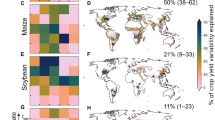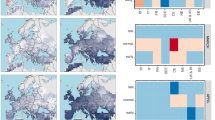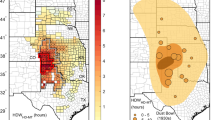Abstract
Europe is the largest producer of wheat, the second most widely grown cereal crop after rice. The increased occurrence and magnitude of adverse and extreme agroclimatic events are considered a major threat for wheat production. We present an analysis that accounts for a range of adverse weather events that might significantly affect wheat yield in Europe. For this purpose we analysed changes in the frequency of the occurrence of 11 adverse weather events. Using climate scenarios based on the most recent ensemble of climate models and greenhouse gases emission estimates, we assessed the probability of single and multiple adverse events occurring within one season. We showed that the occurrence of adverse conditions for 14 sites representing the main European wheat-growing areas might substantially increase by 2060 compared to the present (1981–2010). This is likely to result in more frequent crop failure across Europe. This study provides essential information for developing adaptation strategies.
This is a preview of subscription content, access via your institution
Access options
Subscribe to this journal
Receive 12 print issues and online access
$209.00 per year
only $17.42 per issue
Buy this article
- Purchase on Springer Link
- Instant access to full article PDF
Prices may be subject to local taxes which are calculated during checkout




Similar content being viewed by others
References
Gourdji, S. M., Sibley, A. M. & Lobell, D. B. Global crop exposure to critical high temperatures in the reproductive period: Historical trends and future projections. Environ. Res. Lett. 8, 024041 (2013).
Rahmstorf, S. & Coumou, D. Increase of extreme events in a warming World. Proc. Natl Acad. Sci. USA 108, 17905–17909 (2011).
Chunlei, L. & Richard, P. A. Observed and simulated precipitation responses in wet and dry regions 1850–2100. Environ. Res. Lett. 8, 034002 (2013).
Huntingford, C., Jones, P. D., Livina, V. N., Lenton, T. M. & Cox, P. M. No increase in global temperature variability despite changing regional patterns. Nature 500, 327–330 (2013).
Reyer, C. P. O. et al. A plant’s perspective of extremes: Terrestrial plant responses to changing climatic variability. Glob. Change Biol. 19, 75–89 (2013).
Semenov, M. A. & Shewry, P. R. Modelling predicts that heat stress, not drought, will increase vulnerability of wheat in Europe. Sci. Rep. 1, 66 (2011).
IPCC, Managing the Risks of Extreme Events and Disasters to Advance Climate Change Adaptation A Special Report of Working Groups I and II of the Intergovernmental Panel on Climate Change Summary for policymakers. (Cambridge Univ. Press, 2012).
Rahmstorf, S., Foster, G. & Cazenave, A. Comparing climate projections to observations up to 2011. Environ. Res. Lett. 7, 044035 (2012).
Joshi, M., Hawkins, E., Sutton, R., Lowe, J. & Frame, D. Projections of when temperature change will exceed 2 °C above pre-industrial levels. Nature Clim. Change 1, 407–412 (2011).
FAOSTAT. Available from: http://faostat.fao.org/site/567/default.aspx#ancor (2012) (cited 20 October 2013).
Porter, J. R. & Semenov, M. A. Crop responses to climatic variation. Phil. Trans. R. Soc. Lond. B Biol. Sci. 360, 2021–2035 (2005).
Ewert, F., Rounsevell, M. D. A., Reginster, I., Metzger, M. J. & Leemans, R. Future scenarios of European agricultural land use: I Estimating changes in crop productivity. Agr. Ecosyst. Environ. 107, 101–116 (2005).
Lobell, D. B., Cassman, K. G. & Field, C. B. Crop yield gaps: Their importance, magnitudes, and causes. Annu. Rev. Env. Resour. 34, 179–204 (2009).
Brisson, N. et al. Why are wheat yields stagnating in Europe? A comprehensive data analysis for France. Field Crop Res. 119, 201–212 (2010).
Mitchel, D. A Note On Rising Food Prices (The World Bank, 2008).
Taylor, K. E., Stouffer, R. J. & Meehl, G. A. An overview of CMIP5 and the experiment design . Bull. Am. Meteor. Soc. 93, 485–498 (2012).
Olesen, J. E. et al. Changes in time of sowing, flowering and maturity of cereals in Europe under climate change. Food Addit. Contam. Part A Chem. Anal. Control. Expo. Risk Assess. 29, 1527–1542 (2012).
Rötter, R. P. et al. Modelling shifts in agroclimate and crop cultivar response under climate change. Ecol. Evol. 3, 4197–4214 (2013).
Olesen, J. E. et al. Uncertainties in projected impacts of climate change on European agriculture and terrestrial ecosystems based on scenarios from regional climate models. Climatic Change 81, 123–143 (2007).
Ruiz-Ramos, M., Sánchez, E., Gallardo, C. & Mínguez, M. I. Impacts of projected maximum temperature extremes for C21 by an ensemble of regional climate models on cereal cropping systems in the Iberian Peninsula. Nat. Hazards Earth Syst. Sci. 11, 3275–3291 (2011).
Fischer, G., van Velthhuizen, H. T., Shah, M. M. & Nachtergaele, F. O. Global Agroecological Assessment for Agriculture in 21st Century; Methodol. Results (IIASA, 2002).
Rötter, R. P., Carter, T. R., Olesen, J. E. & Porter, J. R. Crop–climate models need an overhaul. Nature Clim. Change 1, 175–177 (2011).
Kahiluoto, H. et al. Cultivating resilience by empirically revealing response diversity. Glob. Environ. Change 25, 186–193 (2014).
Elsgaard, L. et al. Shifts in comparative advantages for maize, oat and wheat cropping under climate change in Europe. Food Addit. Contam. Part A Chem. Anal. Control. Expo. Risk Assess. 29, 1514–1526 (2012).
Metzger, M. J., Bunce, R. G. H., Jongman, R. H. G., Mücher, C. A. & Watkins, J. W. A climatic stratification of the environment of Europe. Glob. Ecol. Biogeogr. 14, 549–563 (2005).
Semenov, M. A., Donatelli, M., Stratonovitch, P., Chatzidaki, E. & Baruth, B. ELPIS: A dataset of local-scale daily climate scenarios for Europe. Clim. Res. 44, 3–15 (2010).
Trnka, M. et al. Agroclimatic conditions in Europe under climate change. Glob. Change Biol. 17, 2298–2318 (2011).
Kruijt, B., Witte, J-P. M., Jacobs, C. M. J. & Kroon, T. Effects of rising atmospheric CO2 on evapotranspiration and soil moisture: A practical approach for the Netherlands. J. Hydrol. 349, 257–267 (2008).
Olesen, J. E. et al. Impacts and adaptation of European crop production systems to climate change . Eur. J. Agron. 34, 96–112 (2011).
Monfreda, C., Ramankutty, N. & Foley, J. A. Farming the planet: 2. Geographic distribution of crop areas, yields, physiological types, and net primary production in the year 2000. Glob. Biogeochem. Cycle 22, GB1022 (2008).
Acknowledgements
Support from J. Balek (programming and data handling) and D. Semerádová (preparation of Fig. 1) is greatly appreciated. This study was performed thanks to the support of the FACCE-JPI knowledge hub and project MACSUR. The contributions of M.T and Z.Z were funded through a project of the National Agency for Agricultural Research (project ‘Crop modelling as a tool for increasing the production potential and food security of the Czech Republic under Climate Change’ no. QJ1310123) and the ‘Establishment of International Scientific Team Focused on Drought Research’ (no. OP VK CZ.1.07/2.3.00/20.0248). R.P.R. was funded by the Academy of Finland’s NORFASYS project (decision no. 268277). M.R-R. was funded by the Ministry of Economy and Competitiveness (MULCLIVAR project CGL2012-38923-C02-02). Rothamsted Research receives grant-aided support from the Biotechnology and Biological Sciences Research Council of the UK. We acknowledge the World Climate Research Programme’s Working Group on Coupled Modelling, which is responsible for CMIP, and we thank the climate modelling groups (listed in Supplementary Table 2) for making available their model output.
Author information
Authors and Affiliations
Contributions
M.T., M.A.S. and R.P.R. conceived and planned the study; M.T. and Z.Z. led the AgriClim software development; M.T., M.R-R., R.P.R., J.E.O. and K.C.K. performed the parameterization of the software; M.T. performed the calculation and initial analysis; M.A.S. was responsible for development of climate change scenarios and weather data. All the authors jointly developed the final set of indices and contributed to writing the manuscript.
Corresponding author
Ethics declarations
Competing interests
The authors declare no competing financial interests.
Supplementary information
Rights and permissions
About this article
Cite this article
Trnka, M., Rötter, R., Ruiz-Ramos, M. et al. Adverse weather conditions for European wheat production will become more frequent with climate change. Nature Clim Change 4, 637–643 (2014). https://doi.org/10.1038/nclimate2242
Received:
Accepted:
Published:
Issue Date:
DOI: https://doi.org/10.1038/nclimate2242
This article is cited by
-
Nitrogen use efficiency in modern wheat cultivars affected by sowing dates
Cereal Research Communications (2024)
-
Characterization of durum wheat resistance against leaf rust under climate change conditions of increasing temperature and [CO2]
Scientific Reports (2023)
-
A pilot study for climate risk assessment in agriculture: a climate-based index for cherry trees
Natural Hazards (2023)
-
Phenotypic variation in leaf photosynthetic traits, leaf area index, and carbon discrimination of field-grown wheat genotypes and their relationship with yield performance in Mediterranean environments
Planta (2023)
-
Weather, food and predation shape the timing of Marsh Tit breeding in primaeval conditions: a long-term study
Journal of Ornithology (2023)



